New York State has a rich history of forts that played significant roles during various periods, including the Revolutionary War, the Indian Wars, and the Civil Conflict.
These historic sites, strategically dispersed along the Hudson River, Staten Island, East River, and Lake Champlain, offer a glimpse into the evolution of the United States military defenses and the influence of key figures, such as George Washington.
Numerous forts in New York City and its harbor were crucial staging points during the American Revolution. For example, Fort Hamilton guarded the entrance to New York Harbor, while Fort Wadsworth on Staten Island protected the crucial waterways of the Hudson and East Rivers.
Fort Jay on Governors Island and nearby Castle Williams and Castle Clinton were vital in defending the city against British forces.
Further north along the Hudson River, West Point’s Fort Clinton and Fort Montgomery, and Fort Stanwix in Central New York contributed significantly to the Continental Army’s efforts to secure strategic locations and maintain control.
Many of these forts are now managed by the National Park Service, offering special events and self-guided tours for visitors to explore their storied pasts.
Beyond the city limits, New York State boasts several other notable forts with connections to Native Americans, British troops, and revolutionary battles. For instance, Fort Ticonderoga on Lake Champlain served American and British forces during their respective occupations.
At the same time, Fort Ontario near Lake Ontario played a crucial role in the Revolutionary War and later as a training ground during the Civil War.
As fascinating pieces of history, these iconic sites continue to captivate visitors with their natural beauty, distinctive architecture, and narrative of perseverance, courage, and innovation.
Prominent Forts in New York State
Fort Ticonderoga
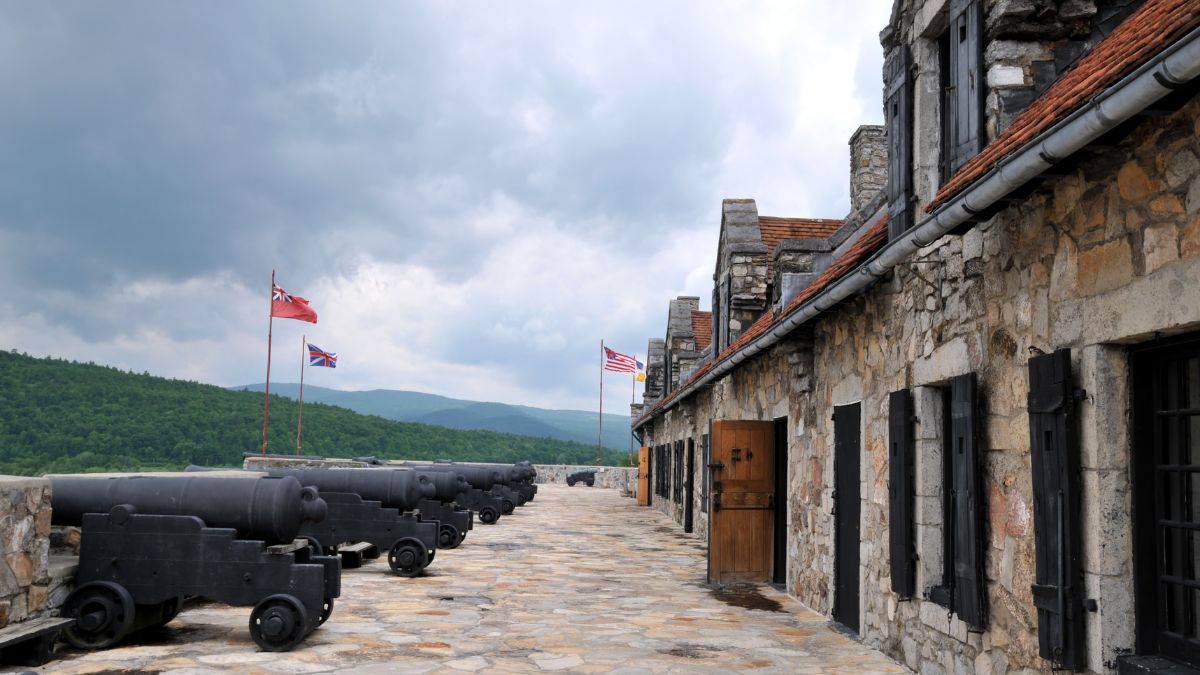
Fort Ticonderoga, once known as Fort Carillon, is an important historic site near the expansive Lake Champlain in upstate New York. The fort’s strategic location and rich history have made it an influential and pivotal part of the American Revolutionary War.
The French built the fort during the French and Indian War (also known as the Seven Years’ War) in 1755. Its original name, Fort Carillon, was a testament to its French roots. The French constructed the fort as part of their defense network against British expansion. Its position along the critical water route of Lake Champlain and the Hudson River made it a valuable asset.
In 1759, however, the British forces seized control of the fort, dramatically altering its course of history. Upon capture, the British renamed it Fort Ticonderoga, derived from an Iroquoian word meaning “it is at the junction of two waterways.” This reflected the fort’s crucial geographic position.
Fort Ticonderoga was a significant barrier to British troops’ southern advancement during the American Revolutionary War. It was a formidable obstacle in their path, contributing to the war’s dynamics.
Benedict Arnold Takes Control of the Fort
This historic fort fell into the hands of American revolutionaries Benedict Arnold and Ethan Allen in 1775. Their surprise attack on the lightly defended fort resulted in the seizure of valuable cannon and artillery, later used to force the British out of Boston.
The success of Arnold and Allen’s raid elevated the strategic importance of Fort Ticonderoga. It continued to be a site of contention for the remainder of the Revolutionary War. Eventually, in July 1777, the British recaptured the fort, holding it until the war’s conclusion in 1783.
Today, Fort Ticonderoga is a testament to the tumultuous history that shaped the United States. Now maintained by the National Park Service, it is a popular destination for history enthusiasts, tourists, and families.
Visitors can immerse themselves in the past through self-guided tours, exploring the fort’s many features and learning about the important events within its walls. The fort also hosts annual special events, often featuring reenactments, history lectures, and other educational programs. These activities aim to preserve the fort’s rich history and make the past come alive for visitors of all ages.
Old Fort Niagara

Old Fort Niagara, located majestically on the eastern bank of the Niagara River, overlooks the beautiful Lake Ontario. This fort brims with centuries-old tales of conflict, collaboration, possession, and power. Established in the late 1600s, the fort’s fascinating history mirrors the changing landscape of North American politics as it successively passed under French, British, and American control.
Imagine standing on the fort’s ancient walls, with the wind from the lake tousling your hair and history whispering in your ears. Old Fort Niagara was once the heart of international contention, its strategic position providing a military advantage to whoever held its keys.
This grand old fortress was a critical staging point during the American Revolutionary War, serving as a fortified base for British troops plotting their maneuvers. The fort, with its perfect vantage point over the river and lake, was not just a base but a barrier, a bastion, and a beacon.
The French Castle
But Old Fort Niagara’s story stretches far beyond the Revolutionary War. The oldest standing structure, “The French Castle,” dates back to 1726. The French erected this stone ‘house’ as a trading post to circumvent fortification restrictions.
But don’t be fooled by the modest name or the merchant-like facade; The French Castle was the heart of the French defense system, a robust fortification designed to resist attacks and withstand sieges.
Today, the whispers of these centuries-old struggles still echo through Old Fort Niagara. Visitors can absorb the riveting history through a journey around the fort.
Walking its hallowed grounds, exploring its preserved buildings, and witnessing reenactments of historical events, you can feel the pulse of the past under your feet. You will be captivated by the natural beauty surrounding this historic monument, the same natural beauty that has bore silent witness to the fort’s unfolding history.
Old Fort Niagara is more than a dry page in a history book. It’s an engaging, immersive dive into the past. With special events and guided tours, visitors can step back in time and experience history as a living entity.
Fort Stanwix

The historic Fort Stanwix is situated along the scenic Mohawk River in the heart of central New York. With its storied past and enduring legacy, this fort offers more than just a glimpse into the nation’s history—it offers a journey through time. Constructed by British forces during the tumultuous French and Indian War, Fort Stanwix became a bulwark of American resistance during the Revolutionary War.
Picture the fort standing as a sturdy sentinel on the river’s edge, with the undulating river reflecting its stern silhouette. The Continental Army, led by patriots determined to carve out a nation from the crucible of war, mounted a spirited defense during the Battle of Oriskany.
Their resolve saw them hold the fort against a significant British assault, successfully thwarting the British advance into the strategically vital Mohawk Valley. This was a battle for a burgeoning nation’s fort and soul.
But the story of Fort Stanwix doesn’t begin or end with stone walls and cannon fire. The land upon which the fort stands was once home to Native Americans, whose rich culture and intimate relationship with the land continue to echo throughout the region.
Before European colonization altered the landscape forever, Native American tribes like the Mohawk, Oneida, and Onondaga inhabited these lands, leaving an indelible imprint on its history.
Today, the guardianship of Fort Stanwix has been assumed by the National Park Service, which is committed to preserving and sharing the fort’s rich narrative tapestry with the public. Visitors are not just observers of history—they are active participants, invited to experience the layers of history that shaped this land and its people.
Through guided tours and interactive exhibits, the fort’s history unfurls like an ancient scroll. It offers insights into the Revolutionary War era, the British and American forces that shaped its destiny, and the Native American cultures that first nurtured the region.
Fort Ontario

Commanding a bluff with a spectacular view over Lake Ontario, Fort Ontario stands as a steadfast sentinel, a monument that encapsulates the ebbs and flows of American history. Established in the mid-1700s, this fort’s strategic location made it a significant military outpost, as it watched over the vast expanse of the lake, a waterway of paramount importance throughout different periods in history.
Imagine the hustle and bustle of Revolutionary War times, with soldiers, commanders, and camp followers crowding within its walls. The fort was a crucial theater during this tumultuous era, where brave men battled, lives were changed, and history was written in indelible ink. Yet the fort’s story did not end with the close of the Revolution; it merely turned a new page.
During the Civil War, Fort Ontario donned a new role as a training ground for U.S. Navy personnel. Picture the intense drilling exercises, the camaraderie among soldiers, and the echoes of military commands ringing out over the waters of Lake Ontario. This was when the fort served to forge and fortify the Navy men, preparing them for the perils of the bloody conflict.
In the 20th century, Fort Ontario continued to play a significant role. It was utilized during both World Wars, serving as a critical outpost in times of global conflict. Later, the U.S. Coast Guard used the fort, its strategic location again being its vital attribute.
Fort Ontario Today
Today, Fort Ontario’s battlements are no longer thronged with soldiers but with visitors. The fort is now a state park; it’s well-preserved buildings and beautiful surroundings invite people from far and wide. As visitors walk through the fort’s robust gates, they step back into time, touching a piece of history that was once alive with the echoes of marching boots and battle cries.
The fort offers a captivating mix of natural beauty and historical legacy. Here, you can learn about the fort’s storied past through exhibits and informative placards, stroll through the fort’s historic structures, or soak in the stunning views of Lake Ontario. It’s a place where history meets nature in a beautiful symphony, an experience that is both educational and enjoyable.
So come and traverse the hallowed grounds of Fort Ontario, let the ancient walls echo their tales, and feel history come alive. Whether you’re a history aficionado, an admirer of architecture, or simply a nature lover, Fort Ontario holds a unique charm bound to captivate you. It’s not just a visit; it’s an immersive journey through the annals of time.
Fort William Henry
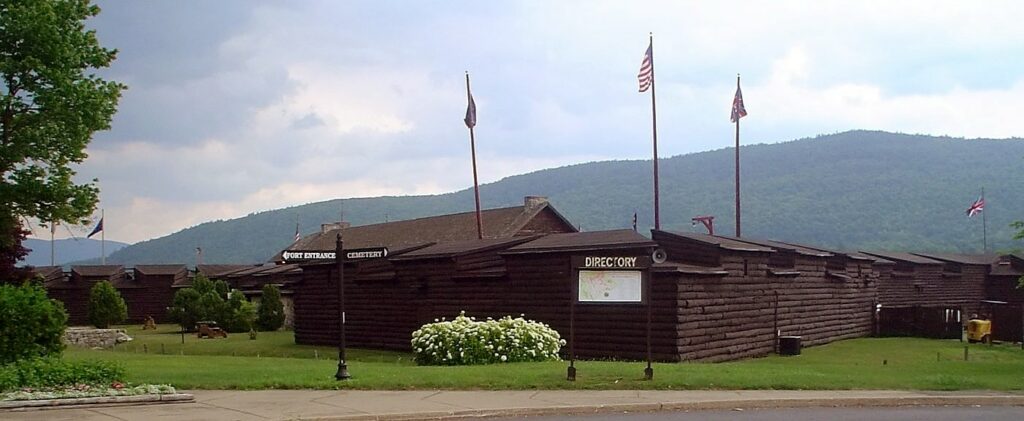
Located on the southern banks of the enchanting Lake George, in the heart of New York State, Fort William Henry bears witness to a chapter of history defining America’s future. This fort, an instrumental piece in the conflict tapestry of the French and Indian War, whispers tales of battles and bravery that can still be heard if you listen closely.
Fort William Henry was erected by British forces in 1755. Positioned strategically between Lake George and Lake Champlain, the fort served as a critical point of control over the area’s major waterways. It was the battleground of many fierce confrontations between the British, French, and their respective Native American allies.
One such confrontation led to its destruction two years later, in 1757, after an intense six-day siege led by the French General Louis-Joseph de Montcalm. It was a pivotal moment that marked a turn in the French and Indian War, a conflict that was but a North American front of the larger Seven Years’ War that had engulfed the continents of Europe, Africa, and parts of Asia.
Fort William Henry inspired the novel ” The Last of the Mohicans.”
In the fort’s short lifespan, it played a significant role in the broader geopolitical chess game of the era. Still, Fort William Henry’s fame reached even greater heights because of its portrayal in literature. James Fenimore Cooper immortalized the fort in his renowned novel “The Last of the Mohicans.”
Set during the French and Indian War, Cooper’s narrative gives us a vivid picture of life during this turbulent period. The siege of Fort William Henry and its devastating aftermath form the novel’s backdrop, adding a layer of romance and adventure to the real-life historical events.
Cooper’s depiction, a blend of historical fact and fiction, lends the fort a special aura. His book evokes images of rugged colonial frontiersmen and Native American allies defending their position against the besieging French forces and their Native American counterparts, all under the watchful eyes of the majestic Adirondack Mountains.
The fort’s history and the novel’s enduring popularity draw thousands of visitors to Lake George each year.
Fort William Henry Today
Today, a reconstructed version of Fort William Henry is a proud symbol of America’s past. Guided tours of the fort offer an immersive experience for history buffs and curious visitors alike, complete with reenactments of the day-to-day life of soldiers stationed at the fort during the mid-18th century.
With its bastions of grey stones, wooden palisades, and earthen walls, the fort invites you to step back in time. You can almost hear the thunder of cannons and smell the gunpowder hanging heavy in the air as you explore its grounds. Nearby, the Fort William Henry Museum offers further insight into the fort’s history and role in the broader conflict between the British and French colonial powers.
Fort Schuyler
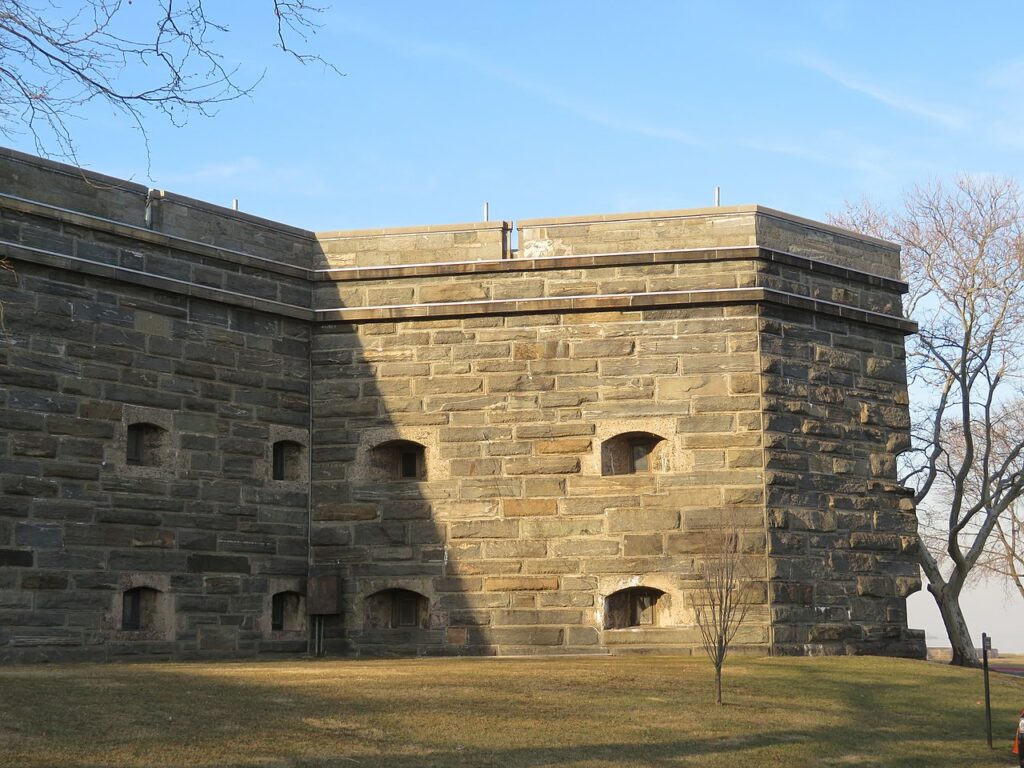
Standing resolutely on Throggs Neck, the southeastern tip of the Bronx, New York City, is Fort Schuyler—a historic site whose roots extend deep into America’s past. Once a bastion of military defense, the fort has evolved over the centuries and today pulses with new energy as the vibrant campus of the State University of New York (SUNY) Maritime College.
Constructed between 1833 and 1856, Fort Schuyler served as a vital line of defense for New York City during the Civil War, prepared to guard the shipping lanes to and from the city against Confederate threats. It was designed in a shape reminiscent of a four-pointed star, a common architectural approach to fortifications in that era. The fort’s thick granite walls, originally built to resist heavy cannon fire, remain imposing today.
Perhaps most intriguing is the fort’s namesake, Major General Philip Schuyler of the Continental Army, a prominent figure during the American Revolutionary War. Schuyler was also one of the first senators from New York State, lending the fort his name and a symbolic connection to the formative period of American history.
SUNY Maritime College
In 1938, it found a new purpose that blended its martial heritage with a commitment to education when it was repurposed as the campus for SUNY Maritime College. The college, itself a beacon of maritime education and training since 1874, found in Fort Schuyler an ideal space to mold the marine engineers, navigators, and naval architects of the future.
Today, Fort Schuyler is home to an array of nautical artifacts and memorabilia that reflect its maritime focus. This includes the Maritime Industry Museum at Fort Schuyler, a tribute to the long and storied history of the shipping industry. The museum displays a rich collection, ranging from detailed ship models to naval relics, all under the original casemates of the fort.
The former parade grounds, where soldiers once performed drills and exercises, are now buzzing with students moving between classes. The dormitories, once the barracks for the soldiers stationed at the fort, house the students pursuing their dreams on the waters of the world. The classrooms, modern extensions to the fort’s original architecture, echo lessons on marine engineering, naval architecture, and maritime law.
Fort Schuyler’s location provides an idyllic setting for a maritime college. Overlooking the convergence of the East River and Long Island Sound, the fort offers breathtaking views of the waters that have been the lifeblood of global commerce for centuries. For the aspiring mariners studying there, the sight is a constant reminder of the seas that await them.
Fort Jay
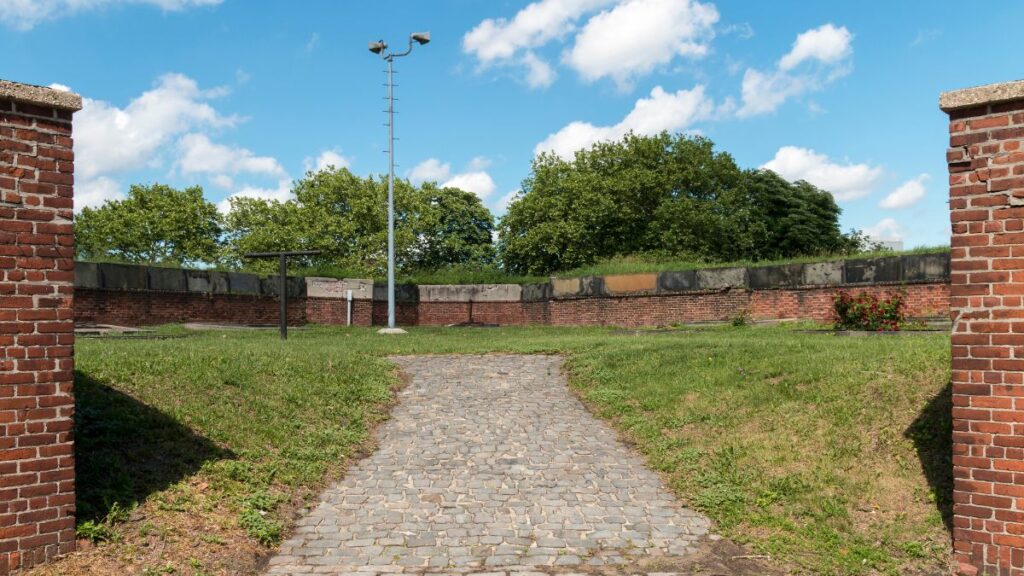
An oasis of green amidst the urban sprawl, Governors Island in New York City is a cherished haven, blending natural beauty, history, and culture. Here, you’ll find Fort Jay, a former military fortification standing with silent resolve, offering us a tangible connection to the past amid the bustling present.
Constructed in 1794 and extensively rebuilt between 1806 and 1809, Fort Jay is a star-shaped fort that served as a crucial defensive structure for the United States in the nation’s early years. Named in honor of John Jay, a Founding Father, and the first United States Chief Justice, Fort Jay has weathered the shifting sands of time with remarkable grace.
The fort is a classic example of 19th-century military architecture. Its five-pointed star design, surrounded by a dry moat, was intentionally designed for strategic defense. From its elevated position, the fort offers panoramic views of New York Harbor—a reminder of the days when its cannons stood ready to protect the city against seaborne threats.
Over the years, Fort Jay served various military roles, from a harbor defense facility to a recruitment station. It has been home to soldiers from various eras, from the fledgling days of the republic to the World Wars of the 20th century. It’s where the air seems heavy with the weight of untold stories and unseen histories.
However, the days of cannons and soldiers have passed for Fort Jay. In 2003, it was designated as a part of the Governors Island National Monument, which also includes another historic fortification on the island, Castle Williams. This transition from military fort to historic monument was akin to the fort opening a new chapter of preservation and public engagement.
Fort Jay Today
Today, Fort Jay stands as a testament to America’s rich history. Walking through the arched gate of the fort, you step onto centuries-old cobblestones. As you explore its historic barracks, gunpowder magazine, and officers’ quarters, you’re walking the same halls that soldiers of yore once did.
The Governors Island National Monument, including Fort Jay, is maintained by the National Park Service, ensuring that this historic gem remains preserved for future generations. Throughout the summer months, rangers offer tours that delve into the fort’s rich past, bringing to life stories of the people who built, lived, and worked in this enduring structure.
If you climb atop the earth-covered walls of Fort Jay, you’re rewarded with stunning views of the Statue of Liberty, the Manhattan skyline, and the sparkling expanse of New York Harbor. It’s a fitting metaphor for Fort Jay’s unique role—as a bridge between the past and present, where history and modernity converge in the heart of one of the world’s most dynamic cities.
Fort Wadsworth
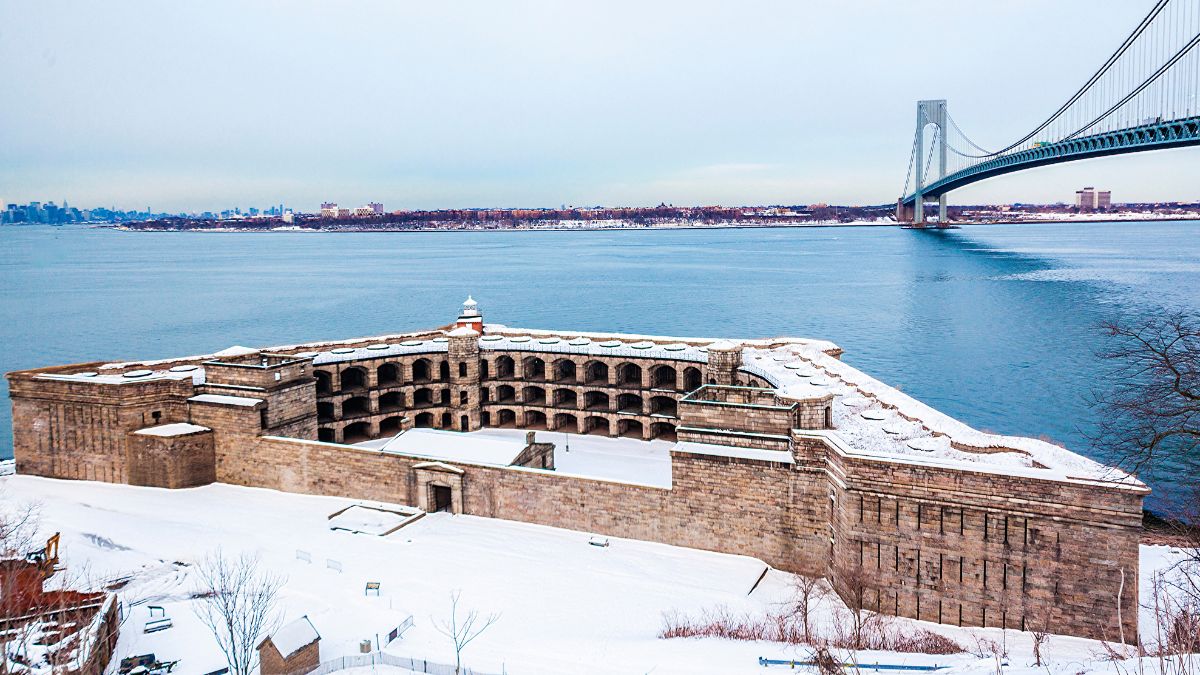
A historic gem awaits your discovery on the northeastern shoreline of Staten Island, New York City. Welcome to Fort Wadsworth, a former military fortification whose roots date back to the American Revolution’s dawn. This remarkable stronghold now serves as a piece of the sprawling Gateway National Recreation Area, bringing together layers of history, nature, and culture for all to explore.
Fort Wadsworth’s origins can be traced back to the late 18th century when British forces established a fortification here during the Revolutionary War, taking advantage of the commanding view it offered of New York Harbor. Named in honor of Brigadier General James Wadsworth, a noted officer during the War of 1812, the fort’s development continued through the 19th and 20th centuries, reflecting the evolution of military architecture and strategy.
Throughout history, the fort has been integral to America’s coastal defense system. Comprising several minor fortifications, including Battery Weed and Fort Tompkins, Fort Wadsworth is a testament to past eras’ military ingenuity. Its expansive structure of granite walls, secret tunnels, and imposing gun batteries offers a fascinating journey into a past marked by conflict and innovation.
Over two centuries of uninterrupted active military use
However, Fort Wadsworth’s claim to fame isn’t just its military significance—it also boasts an uninterrupted record of active military use that lasted more than two centuries, believed to be one of the longest in the United States. Its strategic location and formidable defenses made it an essential asset from the Revolutionary War through World War II and beyond.
This long-standing military legacy shifted in 1995 when the fort became a part of the Gateway National Recreation Area, managed by the National Park Service. This urban park spans three NYC boroughs and offers a diverse blend of wildlife habitats, historic structures, and unique recreational opportunities. Fort Wadsworth adds its unique character to this rich tapestry.
Today, visitors to Fort Wadsworth are treated to a wealth of experiences. Historic structures invite exploration and discovery as stories of the past come alive within the fort’s storied walls. Educational programs and guided tours offer deeper dives into the fort’s history. At the same time, the former military parade grounds, now green open spaces, provide a tranquil backdrop for picnics, outdoor activities, or peaceful contemplation.
Beyond its historical allure, the fort’s geographic position gifts visitors with one of the most breathtaking views in the city. From the overlook, your eyes are drawn to the expansive vista of the Verrazzano-Narrows Bridge—one of the world’s longest suspension bridges—framed by the blue sweep of the New York Harbor and the iconic Manhattan skyline in the distance.
Fort Montgomery

Nestled in the town of Fort Montgomery, New York, along the scenic Hudson River, stands the historic site of Fort Montgomery—a remnant of the tumultuous years of the American Revolution. This strategic stronghold was a critical fortification in the struggle for control over the Hudson River, a key artery of travel and commerce in the 18th century.
Constructed in 1776, Fort Montgomery was more than just a military installation. It symbolized American defiance against British rule, a physical embodiment of the fledgling nation’s determination to protect its liberty. The fort was primarily built to control movement along the Hudson River, serving as a crucial barrier to British forces seeking to divide the rebellious colonies.
Fort Montgomery’s strategic position was its strength but also its vulnerability. The Battle of Fort Montgomery fought on October 6, 1777, saw the fort besieged by a far superior British force. Despite a gallant defense by the American garrison, the fort fell to the British. Its capture was a significant setback for the American cause, although the British victory was somewhat overshadowed by the concurrent, larger Battle of Saratoga to the north.
While the fort’s active life was relatively short-lived, its legacy endures. The ruins of Fort Montgomery today stand as silent witnesses to the past, surrounded by the natural beauty of the Hudson River Valley. Walking among these remnants, visitors can almost hear the clamor of battle and the shouts of soldiers long gone.
National Register of Historic Places
In 1972, the fort’s historical and cultural significance was recognized with its inclusion in the National Register of Historic Places. Today, the Fort Montgomery State Historic Site invites visitors to explore the story of the American Revolution uniquely immersively.
On-site, the Fort Montgomery Visitor Center offers detailed exhibits that delve into the life of the soldiers stationed at the fort, the construction of the fortifications, and the dramatic events of the 1777 battle. Scale models, artifacts, and interactive displays all contribute to bringing the past to life vividly and engagingly.
A short walk from the visitor center, a trail takes you through the fort’s ruins. As you traverse this landscape, interpretive signs guide you, explaining the significance of each section of the fort, from the officer’s quarters to the artillery placements.
The annual Battle of Fort Montgomery reenactment is one of the site’s highlights. This event transforms the grounds into a living history experience, with costumed actors staging mock battles and demonstrations of 18th-century military life, providing a fascinating window into the world of Revolutionary War soldiers.
Fort Crailo

Situated in Rensselaer, New York, on the eastern shore of the Hudson River, is Fort Crailo—a relic of the Dutch colonial era, a testament to a time when North America was a tapestry of European settlements forging its place in a new world. Unlike conventional military forts, Fort Crailo, built in the 17th century, was not a purpose-built fortress but rather a fortified home, providing a fascinating glimpse into the life of early colonial settlers.
Fort Crailo was built by Hendrick Van Rensselaer, a member of the influential Van Rensselaer family, one of the wealthiest and most powerful families in colonial New York. The Dutch-style “patroonship” was a defensive structure and a working farm, reflecting the Van Rensselaers’ key role in the region’s agricultural development.
Constructed of brick, with walls exceptionally thick for a residence, Fort Crailo was designed to provide a haven against potential attacks by Native American tribes or rival European colonists. Its “fort” moniker speaks more to this defensive capability than any military function. Indeed, for much of its history, Fort Crailo served as a family home, a symbol of the blending of cultures that defined the colonial era.
One fascinating aspect of Fort Crailo’s history is its connection to a beloved American holiday song. It is said that during the French and Indian War, British soldiers stationed near the fort penned the original lyrics of “Yankee Doodle Dandy” based on a tune they heard from Dutch settlers. This cheeky ditty became an iconic patriotic anthem during the Revolutionary War.
Fort Crailo Today
Today, Fort Crailo is a treasured historic site maintained by the New York State Office of Parks, Recreation, and Historic Preservation. It houses the Crailo State Historic Site, known colloquially as the “Museum of the Colonial Dutch” in the Hudson River Valley. The museum tells the story of the early Dutch inhabitants of the seventeenth-century colony of New Netherland.
Walking through the restored rooms of Fort Crailo, visitors are transported back to the Dutch colonial era. Period furnishings, artifacts, and interpretive exhibits bring to life the everyday experiences of the Dutch settlers who once resided here. Each room unveils a different facet of colonial life, from the cultivation of crops to the construction techniques of the time.
One of the museum’s highlights is the “A Sweet and Alien Land” exhibit, which showcases the cultural and economic exchange between the Dutch colonists and the native Mohican tribe, providing valuable insights into how different cultures intersected in this new world.
Related: Historic Forts in Washington State
History of Forts in New York State

French and Indian War
During the French and Indian War, forts in New York were crucial due to their strategic positions along important waterways such as the Hudson River and Lake Champlain.
Forts such as Fort Edward, Fort William Henry, and Fort Ticonderoga saw major battles and changes of hands between the British and French forces. Native Americans also participated in this conflict, often siding with the French due to their trading relationships.
American Revolution
The American Revolution brought renewed significance to the forts in New York State. As tensions grew between Great Britain and the American colonies, the Continental Army, led by George Washington, took control of strategic locations such as West Point and Fort Stanwix.
The British focused their efforts on New York City and captured Staten Island, Long Island, and Manhattan, establishing forts like Fort George on Manhattan and Fort Richmond on Staten Island.
Iconic places like Fort Ticonderoga, Crown Point, and Fort Clinton on the Hudson River played crucial roles during the Revolutionary War as they were central points in securing essential supply routes.
Fort Jay on Governors Island and its counterpart, Castle Williams, defended the New York Harbor from British forces.
War of 1812
During the War of 1812, forts in New York State remained critical strategic locations. At the mouth of the Niagara River, Fort Niagara became a vital military post in keeping British forces at bay. Fort Ontario, situated on Lake Ontario, was another crucial position during this conflict.
In response to increased tensions, new forts were constructed along the East River, including Fort Gibson on Ellis Island and Castle Clinton in Battery Park.
Fort Wadsworth on Staten Island and Fort Hamilton in Brooklyn Heights provided additional layers of defense for New York Harbor.
Although the forts in New York did not witness significant battles during the War of 1812, they played a critical role as staging points for American troops and as deterrents to the British invasion.
The forts in New York State represent an essential part of the history of the United States and have since evolved into sites that preserve the nation’s heritage.
Many of these forts now fall under the jurisdiction of the National Park Service and offer special events and self-guided tours showcasing their historical significance and natural beauty.
Fort Structures and Features
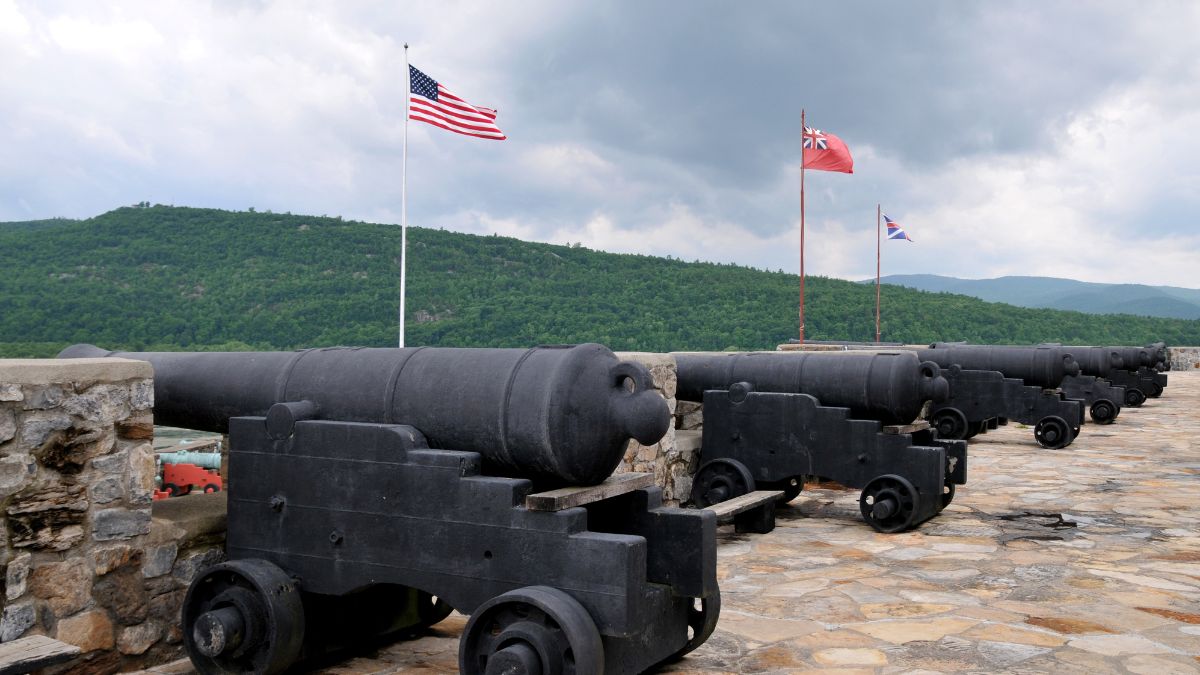
Cannons and Earthworks
In the forts of New York State, cannons were a crucial component for defense against enemy invasions. They were strategically placed along the Hudson River, East River, and around New York City to deter British forces during the American Revolution.
Forts such as Fort Hamilton, Fort Wadsworth, and Fort Jay, situated on Staten Island and Ellis Island, utilized these cannons to protect New York Harbor.
To support the cannon defenses, earthworks were constructed surrounding the forts. These earthworks were a foundation for the cannons and a barrier against enemy attacks. The forts at Lake Champlain, such as Fort Ticonderoga and Crown Point, also featured these earthworks.
Blockhouses
Blockhouses were another essential feature in New York forts during the Revolutionary War, the Indian War, and even the Civil War. Forts like Fort Stanwix, Fort Schuyler, and Fort Tilden employed blockhouses for defensive purposes.
They were constructed with sturdy materials to provide a safe and secure location for troops stationed in these forts in upstate New York. Additionally, the central location of West Point made blockhouses such as Fort Clinton vital in securing the Hudson River.
Madison Barracks
Named after President James Madison, the Madison Barracks in Sackets Harbor played a significant role in the defense of the United States throughout its history.
This strategic location protected the US Navy, with its proximity to Lake Ontario and the Long Island Sound. The barracks housed soldiers from the 10th Mountain Division and supported the training of the U.S. Coast Guard.
Siege Strategies
During conflicts, various siege strategies were employed by American and British forces across numerous forts in New York State. The Siege of Fort William Henry at Lake George demonstrated the effective coordination between Native Americans and British troops. Meanwhile, under George Washington’s command, the Continental Army used stealthy tactics around Fort Ticonderoga to gain an advantageous position.
Forts in New York, such as Forts Hamilton and Wadsworth, were vital staging points and played an integral part in defending essential locations. The rich history and natural beauty surrounding these forts make them popular destinations for visitors, who can tour additional buildings and explore their significance through self-guided tours and special events organized by the National Park Service.

Cory is a website owner and content creator who enjoys fishing, history, coin collecting, and sports, among other hobbies. He is a husband and father of four.
Romans 15:4 For whatever was written in former days was written for our instruction, that through endurance and through the encouragement of the Scriptures we might have hope.

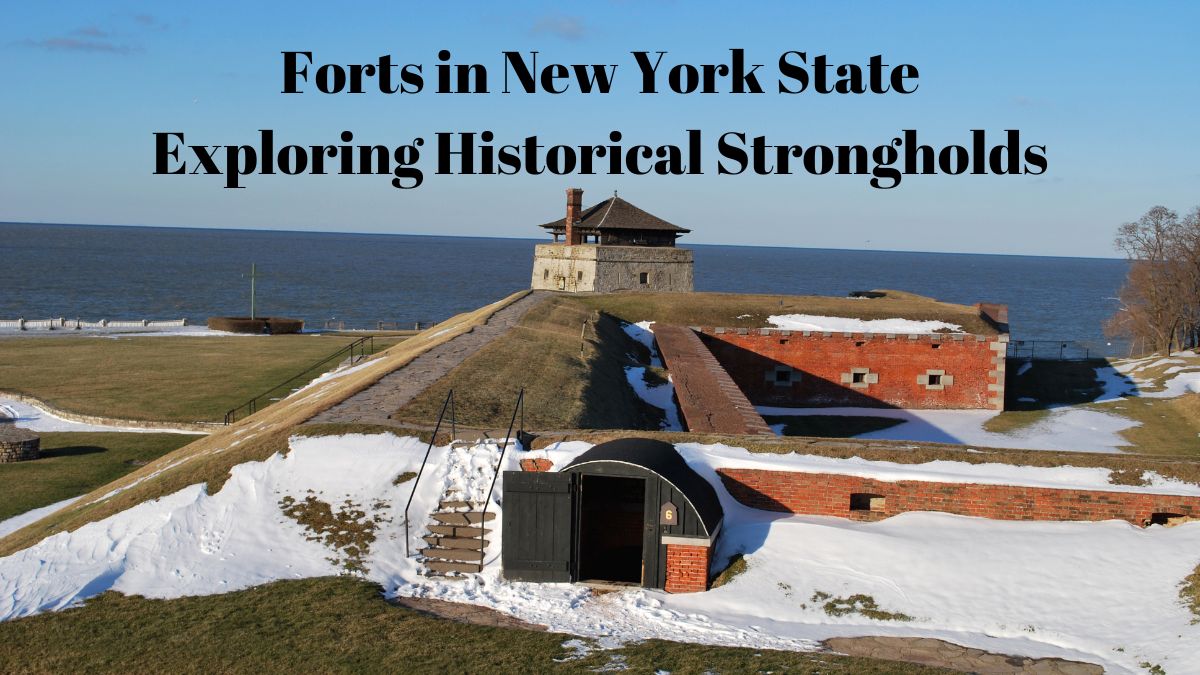
I blog quite often and I truly appreciate your content.
This great article has really peaked my interest. I will
book mark your website and keep checking for new details
about once per week. I opted in for your Feed as well.